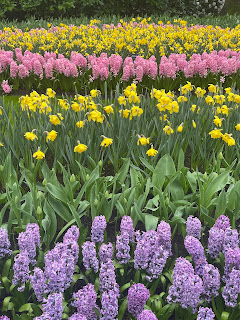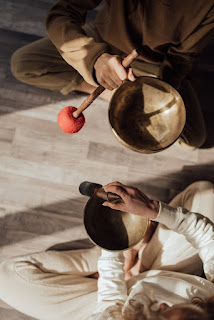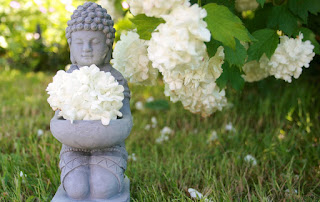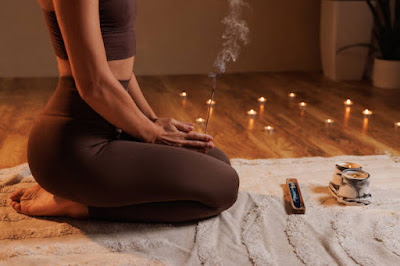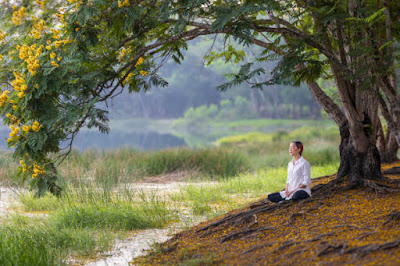Spring Into Balance: Yoga for Grounding and Growth During Seasonal Transitions
Themes in Nature, Yoga Philosophies, and Literature for Late Spring
Spring is not just a season of external blooming but a profound metaphor for the inner awakening that yoga seeks to cultivate. Its themes—emergence, impermanence, and interconnectedness—echo deeply within yoga philosophies, offering a sacred lens through which to view our existence.
Emergence and Satya (Truth)
Spring’s emergence from winter’s stillness mirrors satya, the yogic principle of truth. As the earth sheds its dormancy, revealing tender shoots and vibrant blossoms, we’re invited to uncover our own authentic essence. This isn’t merely about physical renewal but a call to align with our deepest reality—stripping away illusions or stagnations that obscure who we are. In yoga, satya asks us to live in harmony with our true nature, much like spring reveals the inherent life waiting beneath the surface. Rumi’s words resonate here: “The breeze at dawn has secrets to tell you. Don’t go back to sleep.” Spring’s awakening urges us to listen and embody this truth.
Impermanence and Aparigraha (Non-Attachment)
The fleeting beauty of spring—cherry blossoms falling, rains passing—embodies aparigraha, the practice of non-attachment. Each bloom, though radiant, is transient, teaching us to embrace change without clinging. In yoga, aparigraha encourages releasing the need to grasp at permanence, whether in possessions, identities, or moments. Spring’s ephemeral nature becomes a teacher, showing us that letting go is not loss but a gateway to freedom. This aligns with the Bhagavad Gita’s wisdom: “The self is not born, nor does it die; it does not come into being, nor cease to exist.” Spring reminds us that beneath the flux lies an unchanging essence.
Interconnectedness and Sangha (Community)
Spring’s symphony—birds singing, bees humming, flowers opening—reflects sangha, the yogic concept of community and unity. No element of spring exists in isolation; each relies on the other in a delicate dance of life. Yoga philosophy extends this to our human experience, emphasizing that we are part of a greater whole. Practicing in late spring, we can feel this interconnectedness—our breath syncing with the wind, our energy with the earth’s pulse. Walt Whitman captures this: “I believe a leaf of grass is no less than the journey-work of the stars.” Spring invites us into this cosmic web, deepening our sense of belonging.
Why Yoga for Spring?
Spring is a season of awakening. After months of cold, the body craves movement, breath, and connection. Yoga poses tailored for spring help relieve stress and promote relaxation, making it easier to adapt to seasonal changes. A certified yoga instructor can guide you through a yoga journey that supports overall well-being. Whether in a yoga studio or at home, people practice yoga to tap into its mental benefits, such as clarity and calm. Hatha yoga, with its emphasis on breath and posture, is particularly effective for grounding during this time.
Benefits of a Spring Yoga Practice
A consistent yoga practice offers numerous benefits. It helps manage stress, improves flexibility, and strengthens the body. Specific yoga poses, like child’s pose and corpse pose, encourage relaxation techniques that soothe the mind. The spring equinox is an ideal time to begin, as the season’s energy supports new habits. Practicing yoga fosters a sense of balance, aligning the body with nature’s cycles. Deep breaths and mindful movements create mental clarity, while poses like mountain pose build physical stability.
Setting Up Your Yoga Space
To begin, create a comfortable yoga space. Place a mat on a flat surface, ensuring enough room for movement. A folded blanket can support knees or hips during seated poses. If practicing in person at a yoga studio, ensure the environment feels welcoming. For home practice, choose a quiet area with natural light to evoke spring’s vibrancy. Keep props like blocks or straps nearby to adjust poses for comfort. This setup enhances focus and supports a grounding practice.
Breath and Meditation for Grounding
Breath is the foundation of yoga. Begin with deep breaths to center the mind. Sit in a comfortable seat, spine straight, and breathe deeply through the nose. This promotes relaxation and prepares the body for movement. Meditation complements breathwork, helping release stress. Focus on the present moment, letting go of distractions. During the spring equinox, visualize growth and renewal with each inhale. These relaxation techniques anchor the mind, fostering a sense of calm.
Key Yoga Poses for Spring
Mountain Pose
Stand tall with feet hip-width apart, arms alongside the body, and palms facing forward. Engage the legs and lift through the crown of the head. This pose builds stability and grounds the body, perfect for the spring transition.
Child’s Pose
From a kneeling position, sit back on the heels and fold forward, resting the forehead on the mat. Arms can rest alongside or extend forward. Child’s pose promotes relaxation and relieves stress, offering a gentle start to practice.
Downward Facing Dog
From a tabletop position, lift the hips toward the ceiling, forming an inverted V shape. Press into the palms and keep knees slightly bent if needed. This pose stretches the body and energizes the mind.
Seated Forward Bend
Sit with legs extended, feet flexed. Hinge at the hips and fold forward, reaching for the feet or shins. A folded blanket under the sitting bones can support tight hamstrings. This pose calms the mind and stretches the back.
Cow Pose
In a tabletop position, inhale and lift the chest, dropping the belly toward the mat. Shoulders stay away from the ears, and the head lifts slightly. Cow pose opens the chest and promotes spinal flexibility.
Corpse Pose
Lie flat on the back, arms alongside the body, palms facing up. Let the legs relax naturally. Breathe deeply, allowing the body to release tension. Corpse pose is ideal for meditation and grounding at the end of practice.
Structuring Your Spring Yoga Practice
A balanced yoga practice includes a warm-up, active poses, and a cool-down. Begin with breathwork and gentle stretches, like child’s pose, to prepare the body. Move into standing poses, such as mountain pose and downward facing dog, to build strength. Incorporate seated poses, like seated forward bend, for flexibility. End with corpse pose for relaxation. Adjust the sequence based on energy levels, using props to support knees or shoulders as needed.
Incorporating Movement and Flow
Spring yoga thrives on fluid movement. Transition between poses with breath, creating a sense of flow. For example, step the right foot forward from downward facing dog into a lunge, keeping the front knee aligned. Lift arms overhead for a gentle twist, then return to tabletop position. Repeat on the left side, stepping the left foot forward. This sequence energizes the body and aligns with spring’s dynamic energy.
Focus on Alignment and Safety
Proper alignment prevents injury. In poses like downward facing dog, press evenly into the palms and keep shoulders relaxed. In seated forward bend, hinge at the hips to protect the cervical spine. If the front knee feels strained in lunges, place a folded blanket underneath. A certified yoga instructor can offer adjustments for safe practice. Listen to the body and modify poses to suit individual needs.
Spring Equinox and Yoga
The spring equinox, when the sun crosses the celestial equator, symbolizes balance. Yoga mirrors this by harmonizing body and mind. Poses like mountain pose and cow pose ground the body, while breathwork fosters mental clarity. Practicing yoga during the equinox connects you to the northern hemisphere’s renewal or the southern hemisphere’s shift. This seasonal marker inspires a practice that supports growth and well-being.
Adapting Yoga for All Levels
Yoga is accessible to everyone. Beginners can start with child’s pose or corpse pose, focusing on breath. Intermediate practitioners can explore flow sequences, stepping the right foot or left foot forward in lunges. Advanced yogis might deepen stretches in seated forward bend or hold poses longer. Use props like blocks or blankets to adjust poses. A yoga studio or online class with a certified yoga instructor can guide all levels.
Mental Benefits of Yoga in Spring
Spring yoga enhances mental well-being. Poses like child’s pose and corpse pose promote relaxation, reducing stress. Breathwork and meditation sharpen focus, helping navigate seasonal transitions. The mental benefits of practicing yoga include improved mood and resilience. By aligning with the spring equinox, yoga fosters a sense of renewal, supporting emotional growth.
Building a Consistent Practice
Consistency is key. Practice yoga two to three times a week, starting with 20-minute sessions. Begin with breath and simple poses, like mountain pose, to build confidence. Gradually increase duration and complexity, adding poses like downward facing dog or cow pose. A yoga studio can provide structure, or follow online classes for flexibility. Track progress to stay motivated on your yoga journey.
Community and Connection
Yoga fosters connection. Join a yoga studio for in-person classes to build community. Practicing with others during the spring equinox amplifies the season’s energy. Online platforms also offer group classes, connecting people across the northern and southern hemispheres. Share your yoga journey with friends or family to inspire each other.
Closing Your Practice
End each session with corpse pose, lying flat and breathing deeply. This seals the practice, allowing the body to absorb benefits. Reflect on the session, noticing how the body and mind feel. Visualize spring’s growth, letting go of stress. This moment of stillness supports overall well-being and prepares you for the day.
Journaling for Reflection
After savasana, sit comfortably and journal, letting spring’s deeper themes guide your pen. This practice unearths insights buried within, connecting your personal journey to yoga’s philosophies and the season’s mysteries. Below are prompts designed to probe the soul, encouraging you to explore truth, impermanence, and unity in ways that feel alive and transformative.
Journaling Prompts
Emergence and Satya (Truth)
What truth about yourself have you felt stirring this spring, perhaps hidden beneath layers of habit or fear?
How might embracing this authenticity shift your life or practice, like a flower breaking through soil?
Impermanence and Aparigraha (Non-Attachment)
Reflect on something you’ve held onto—a thought, a role, a memory—that spring’s fleeting beauty invites you to release. What freedom or lightness might emerge if you let it fall away, like petals in the wind?
Interconnectedness and Sangha (Community)Recall a moment this spring when you felt part of something larger—perhaps in nature, with others, or within yourself. How does this sense of unity reshape your understanding of your place in the world?
What in my life is blossoming right now, and how can I nurture it?
Where do I feel the strongest sense of balance in my day-to-day rhythm?
What habits or thoughts need grounding before the intensity of summer begins?
How does my yoga practice reflect the energy I see in nature right now?
Which lines or teachings from yoga philosophy resonate with this time of year?
What does it mean to act with clarity and steadiness as things around me accelerate?
What areas of my life could benefit from more presence and less effort?
How does rest help me grow?
What beauty did I notice in nature this week?
What would it feel like to move through the next season with trust rather than control?
The Eternal Beneath the EphemeralInspired by spring’s cycles and yoga’s teachings, consider what remains steady in you amid life’s changes. How can you root into this unchanging core while honoring the season’s flow?
Awakening to the SubtleWhat quiet, often overlooked gift of spring—a sound, a scent, a sensation—has spoken to you lately? How can you carry this awareness into your yoga practice to deepen your presence?
Use these prompts to guide your reflections. They are inspired by late spring energy, themes in yoga philosophy, and literature that celebrates nature and renewal.
Conclusion
Spring yoga is a powerful way to embrace the March equinox and seasonal transitions. Through yoga poses, breath, and meditation, you can ground the body and foster growth. Whether in a yoga studio or at home, a consistent practice promotes relaxation, relieves stress, and enhances well-being. Begin your yoga journey this spring, stepping one foot forward into balance and renewal.
